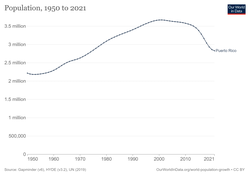Demographics of Puerto Rico
| Demographics of Puerto Rico | |
|---|---|

Population Change Timeline (1961-2003)
|
|

Population Density
|
|
| Population (2016) | 3,411,307 |
| Male population (2010) | 1,785,171 |
| Female population (2010) | 1,940,618 |
| Population growth | -1.32% |
| Birth rate | 9.8/1,000 |
| Death rate | 8.6/1,000 |
| Infant mortality rate | 8.24/1,000 |
| Life expectancy | 78.29 years |
| Nationality | Puerto Rican |
| Demographic bureaus | 2010 United States Census |
The population of Puerto Rico has been shaped by Amerindian settlement, European colonization especially under the Spanish Empire, slavery and economic migration. This article is about the demographic features of the population of Puerto Rico, including population density, ethnicity, education level, health of the populace, economic status, religious affiliations and other aspects of the population.
Sometime between 400 B.C.E. and 100 A.C.E., the Arawak group of Amerindians inhabited Puerto Rico. Around 600 A.C.E., the Arawak no longer lived on the island, perhaps because they had integrated with another culture, or perhaps because they had been killed by illness. By 1000 A.C.E. indigenous Taíno inhabited the island. They called the island, Borikén (alt. Borinquén), which means "land of the valiant one," and later, Puerto Ricans called themselves "Boricua" to embrace their indigenous identity. In the 15th century, the Carib lived on nearby islands and periodically invaded Taíno villages.
The Spanish conquered the island, assuming government in 1508, colonized it, and assumed hegemony over the natives. The Taíno population dwindled due to disease, tribal warfare, and forced labor, so the Spanish began importing large numbers of slaves from Africa. Spanish men arrived on the island disproportionately to Spanish women; African and Taíno women would sometimes marry them, resulting in a mulatto or "mixed" tri-racial ethnicity.
In the late 18th century the number of African slaves began to dwindle on the island. The British ban on slavery resulted in slave raids on Puerto Rico. Many slaves also escaped to neighboring islands.
During the 19th century large numbers of immigrants from Spain, as well as numerous Spaniards living in former Spanish colonies in South America, also arrived in Puerto Rico (See Spanish immigration to Puerto Rico). Although the vast majority of settlers came from Spain, Catholics from France, Ireland, Italy and other European countries were also granted land from Spain during the Real Cedula de Gracias de 1815 (Royal Decree of Graces of 1815), were allowed to settle in the island with a certain amount of free land and enslaved persons. During the early 20th century Jews began to settle in Puerto Rico. The first large group of Jews to settle in Puerto Rico were European refugees fleeing German–occupied Europe in the 1930s. Puerto Rico's economic boom of the 1950s attracted a considerable number of Jewish families from the U.S. mainland, who were joined after 1959 by an influx of Jewish emigres from Castro's Cuba.
...
Wikipedia
